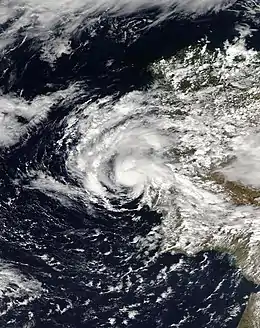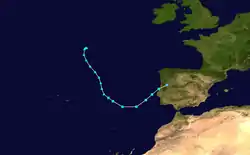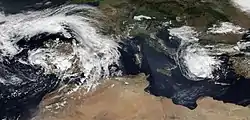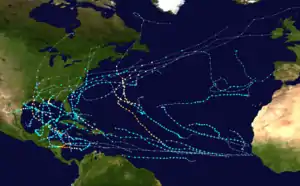Subtropical Storm Alpha (2020)
Subtropical Storm Alpha was a subtropical cyclone that made landfall in Portugal, the first ever recorded occurrence for the country. The twenty-fourth cyclone and twenty-second named storm of the extremely active and record-breaking 2020 Atlantic hurricane season, Alpha originated from a large non-tropical low that was first monitored by the National Hurricane Center on 15 September. Initially not anticipated to transition into a tropical cyclone, the low gradually tracked south-southeastward for several days with little development. By early on 17 September, the low had separated from its frontal features and exhibited sufficient organization to be classified as a subtropical cyclone as it approached the Iberian Peninsula, becoming a subtropical storm around that time. Alpha then made landfall just north of Lisbon, Portugal during the evening of 18 September, rapidly weakened, and dissipated on 19 September.
| Subtropical storm (SSHWS/NWS) | |
 Alpha shortly before landfall in Portugal on 18 September | |
| Formed | 17 September 2020 |
|---|---|
| Dissipated | 19 September 2020 |
| Highest winds | 1-minute sustained: 50 mph (85 km/h) |
| Lowest pressure | 996 mbar (hPa); 29.41 inHg |
| Fatalities | 1 total |
| Damage | $1 million (2020 USD) |
| Areas affected | Portugal, Spain |
| Part of the 2020 Atlantic hurricane season | |
At least two EF1 tornadoes were confirmed in Portugal and one person was killed from high winds. Total damages from the storm were estimated to be in the millions of euros.[1]
Meteorological history

On 15 September, the National Hurricane Center began to monitor a non-tropical low-pressure system well north of the Azores for possible development into a tropical or subtropical cyclone, as it was expected to track close to a warm pool of water to the west of Portugal.[2] Development was initially very slow for the system, and the NHC did not consider it likely to develop at the time.[3] The low tracked generally south-southeastward for the next day, and as it approached closer to the Iberian Peninsula chances appeared to be decreasing for any subtropical development of the cyclone.[3] Nonetheless, thunderstorm activity became more concentrated and organized near the center of the low as it gradually shed its frontal features, although the central low struggled to become the dominant feature.[4] This central low feature soon enough became encased within the larger non-tropical low, and thunderstorm activity persisted.[5] A combination of radar imagery from Portugal, scatterometer passes, and satellite derived wind data soon revealed Subtropical Storm Alpha had formed at 16:30 UTC, on 18 September, just a couple hundred miles from the coast of Portugal, and was already producing sustained winds up to 80 km/h (50 mph)[6] and wind gusts up to 108 km/h (67 mph).[7] However, in post-storm analysis, the NHC determined that the system had formed over 34 hours earlier at 06:00 UTC on September 17.[8]
Two hours later, at 18:30 UTC, Alpha made landfall near São Pedro de Moel in central Portugal at peak intensity,[7] with an atmospheric pressure of 996 mbars (29.44 inHg), based on a surface pressure of 999 mbar (29.50 inHg) being recorded in Monte Real, Portugal, well north of the cyclone.[9] Alpha then quickly weakened as it headed further into the Iberian Peninsula.[10] It dissipated 06:00 UTC on 19 September.[8]
Preparations and impact

In preparation for Alpha on 18 September, orange warnings were raised for high wind and heavy rain in the Coimbra and Leiria districts of Portugal.[11] Winds due to Alpha and its associated non-tropical low caused widespread power outages, fallen trees and damaged dozens of vehicles.[12] Supercell thunderstorms associated with the system spawned at least two confirmed EF1 tornadoes in Beja and Palmela.[12][13] Extreme street flooding also became prominent in some cities in western Portugal, particularly Setúbal.[12] Winds brought down a radio tower in Leiria and damage was described as "unrepairable".[14] Throughout the country, there were 203 reports of fallen trees, 174 reports of minor flooding, 88 structures damaged and 82 roads blocked by debris. Of these reports, 143 were in the Leiria District and 135 were in the Lisbon District.[15]
In Spain, the front associated with Alpha caused a train to derail in Madrid, although no one was seriously injured. A woman died in Calzadilla after a roof collapsed on top of her.[16] Alpha also caused lightning storms on Ons Island which led to a forest fire.[16]
Naming and records
Alpha is the earliest 22nd Atlantic tropical / subtropical storm, surpassing the old mark of October 17, set by Hurricane Wilma in 2005,[17] and marked the second time (along with 2005) that the main naming list has been exhausted and Greek letters were used.[18] Upon landfall, Alpha became the first recorded tropical or subtropical cyclone to make landfall in mainland Portugal, and only the third known to have made landfall in continental Europe, following a hurricane in Spain in 1842 and Hurricane Vince (as a tropical depression) also in Spain in 2005.[19]
See also
- Tropical cyclones in 2020
- Other storms of the same name
- Hurricane Leslie (2018) – long-lived Atlantic hurricane whose extratropical remnant made landfall in Portugal
References
- "Global Catastrophe Recap September 2020" (PDF). Aon. 8 October 2020. Archived (PDF) from the original on 8 October 2020. Retrieved 8 October 2020.
- Eric Blake (15 September 2020). "NHC Graphical Outlook Archive". nhc.noaa.gov. Retrieved 18 September 2020.
- Robbie Berg (15 September 2020). "NHC Graphical Outlook Archive". nhc.noaa.gov. Retrieved 18 September 2020.
- Andrew Latto (17 September 2020). "NHC Graphical Outlook Archive". nhc.noaa.gov. Retrieved 18 September 2020.
- David Zelinsky (18 September 2020). "NHC Graphical Outlook Archive". nhc.noaa.gov. Retrieved 18 September 2020.
- Eric Blake (18 September 2020). "Subtropical Storm Alpha Special Discussion Number 1". nhc.noaa.gov. Retrieved 18 September 2020.
- Setembro 2020 – Portugal Continental (PDF). Boletim Climatológico Mensal (Report) (in Portuguese). Instituto Português do Mar e da Atmosfera. October 2020. ISSN 2183-1076. Retrieved 9 November 2020.
- Brown, Daniel P. "National Hurricane Center Tropical Cyclone Report:Subtropical Storm Alpha" (PDF). National Hurricane Center. Retrieved 1 February 2021.
- Eric Blake (18 September 2020). "Subtropical Storm Alpha Discussion Number 2". nhc.noaa.gov. Retrieved 18 September 2020.
- Dave Roberts (19 September 2020). "Post-Tropical Cyclone Alpha Advisory Number 3". nhc.noaa.gov. Retrieved 19 September 2020.
- "Ciclone Alpha: Aviso laranja por agravamento de mau tempo hoje no distrito de Coimbra | Notícias de Coimbra". www.noticiasdecoimbra.pt. Retrieved 18 September 2020.
- "Tornados em Beja e Palmela ocorreram devido a supercélulas. Fim de semana chega com a tempestade subtropical Alpha". Observador.
- "Tornado🌪️ em é Lagameças, perto de #Setubal. Impressionante! Credit: Café Esperança #Invest99L". Twitter. Retrieved 18 September 2020.
- Rainho, Martine. "Leiria: Ciclone Alpha derruba torre da Rádio 94FM". Região de Leiria (in Portuguese). Retrieved 19 September 2020.
- "Quedas de árvores, inundações e estruturas que caíram. Foram registadas 555 ocorrências devido ao mau tempo e mantém-se aviso amarelo" (in Portuguese). SAPO. 19 September 2020. Retrieved 19 September 2020.
- "Los estragos del temporal: Una mujer muere en Cáceres al caer un tejado y un tren descarrila en Madrid". telecinco (in Spanish). 18 September 2020. Retrieved 18 September 2020.
- Sosnowski, Alex (17 September 2020) [Updated September 20, 2020]. "Tropical Storm Beta to spend days pounding Gulf Coast". newscentermaine.com. Portland, Maine: WCSH. Retrieved 6 November 2020.
- Machemer, Theresa (24 September 2020). "Out of Names, National Hurricane Center Calls New Storms by Greek Letters". Smithsonian. Retrieved 5 November 2020.
- Masters, Jeff; Henson, Bob (18 September 2020). "A slew of weather events – including two named storms troubling Europe – pose challenges far and wide". Yale Climate Connections. New Haven, Connecticut: Yale Center for Environmental Communication, Yale School of the Environment. Retrieved 6 November 2020.
External links
| Wikimedia Commons has media related to Subtropical Storm Alpha (2020). |
- The National Hurricane Center's Advisory Archive on Subtropical Storm Alpha
- National Hurricane Center (NHC)
